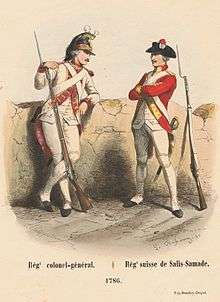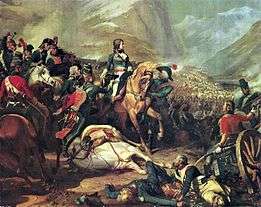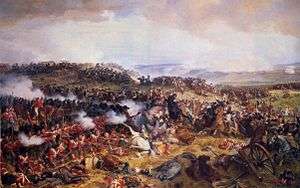Henri Félix Emmanuel Philippoteaux

Henri Félix Emmanuel Philippoteaux (1815–1884) was a French artist. He was born in Paris, France, studied art at the studio of Leon Cogniet,[1] and first exhibited his work at the Paris Salon of 1833.[1]
One of his best-known works was a depiction of the Siege of Paris during the Franco-Prussian War,[2][3] painted in the form of a cyclorama, a type of large panoramic painting on the inside of a cylindrical platform designed to provide a viewer standing in the middle of the cylinder with a 360° view of the painting. Viewers surrounded by the panoramic image are meant to feel as if they are standing in the midst of a historic event or famous place.
Philippoteaux also produced a large number of works chronicling the rise and successes of Napoleon Bonaparte, including a portrait of Napoleon in his regimental uniform and a group of paintings of French victories in the Napoleonic Wars. Philippoteaux was awarded the Légion d'honneur in 1846.[1][4]
Philippoteaux's son Paul Philippoteaux was also an artist; both were famous for their production of cycloramas. Father and son collaborated on The Defence of the Fort d'Issy in 1871. They also collaborated on a cyclorama of the Battle of Gettysburg that became a celebrated work in the United States:
"One cyclorama, however, halted the slide in popularity, and almost single-handedly revived the public's interest in the medium for another decade...this singular creation was initially painted in 1882-83 by Henry F. Philippoteaux and Paul Philippoteaux, a father and son team of French artists...within a year, half a million people had stood before it."[5]
Father and son enhanced the artistic effect of their cylindrical painting by adding a third dimension, including elements of diorama placed in front of the painting, and by incorporating sections of walls and battlefield objects that blended into the painted parts of the presentation.[6]
He died in 1884 and his obituary in the New York Times appeared on November 10, 1884.[1]
References

- 1 2 3 4 "Death of a French Painter" (PDF). The New York Times. November 10, 1884.
- ↑ "The Panorama of a battle. The picture of the Siege of Paris" (PDF). The New York Times. September 17, 1882. Retrieved 2009-05-18.
- ↑ Panorama of the Siege of Paris (by Philippoteaux) exhibited in Los Angeles
- ↑ Viardo, Louis. The Masterpieces of French Art Vol I. Ed. WM. A. ARMSTRONG. PHILADELPHIA: GEBBIE & CO., Publishers. 1883., p. 70.
- ↑ Sokalski, JA (2007). Pictorial illusionism: the theater of Steele MacKaye. McGill Queens University Press. p. 133. ISBN 978-0-7735-3204-5.
- ↑ Sokalski, p. 134
Partial list of works
- Les Gentilshommes du Duc d'Orléans
- The Iceberg, Episode of the Wars of America, (1833)
- The Retreat from Moscow, (1835)
- The Capture of Ypres. (1837)
- Death of Turenne
- The Siege of Antwerp in 1792
- Colonel Fr. Ponsonby rescued on the battlefield of Waterloo, by a French Officer
- They are in our House (1880)
- The Periwinkle
- The Deception
- The Blade of Grass
- The Return from the Dram-shop, (1853)
- The Battle of the Raab,
- The Passage of the Tagliamento
- The Siege of Antwerp in 1832
External links
- Gallery of Philippoteaux works at New York Public Library
- Philippoteaux's The Siege of Paris cyclorama
- Panorama of the Defence of Paris, 1875 work at google books
- Partial list of his oil paintings
-

The Numbering of the Israelites, engraving
-

Arrival of "la Dorade" at Courbevoie on 14 December 1840., 1867. Château de Malmaison
-

Napoleon at the Battle of Rivoli, oil on canvas
